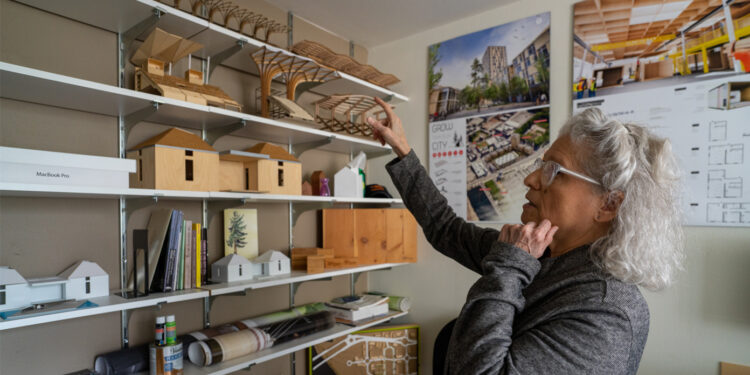University of Oregon-led Team Named NSF Regional Innovation Engines Semifinalist

A University of Oregon-led initiative to revolutionize the mass timber sector in the Pacific Northwest has been selected as a semifinalist in the highly competitive National Science Foundation Regional Innovation Engines program.
The NSF Engine: Oregon Mass Timber Innovation Engine, led by principal investigator Judith Sheine (pictured in the above cover photo from 2023), professor of architecture in the UO College of Design and director of design of the Tallwood Design Institute, is among just 29 semifinalist teams nationally.
“This significant step forward for the University of Oregon, and its project to build an even stronger mass timber industry in our state is a powerful testament to my alma mater’s innovative spirit and to the research benefits from the CHIPS & Science Act investments that I worked to pass,” said U.S. Senator Ron Wyden of Oregon. “Mass timber is revolutionizing the construction business with better and safer buildings. The U of O deserves major credit for earning this honor and I am confident it has both the capacity and talent to fully develop the employment and economic benefits of mass timber.”
“Oregon’s timber industry is the long-time cornerstone of our state’s identity. This project represents a new chapter, one where sustainability and innovation work together,” said U.S. Senator Jeff Merkley of Oregon. “The Oregon Mass Timber Innovation Engine, and the work done by the University of Oregon, highlight our state’s leadership in sustainable construction and creating economic opportunity.”
The NSF Engine: Oregon Mass Timber Innovation Engine, led by principal investigator Judith Sheine, professor of architecture in the UO College of Design and director of design of the TallWood Design Institute, is among just 29 semifinalist teams nationally. The announcement builds on the project’s momentum from a $1 million NSF Engine strategic planning award granted in 2023 and the work of the TallWood Design Institute, a joint initiative of the UO and Oregon State University.
“This exciting next step affirms our region’s potential to lead a national transformation of our construction industries. The mass timber initiative leverages Oregon’s world-class strengths in timber R&D, abundant forest resources, and manufacturing capacity to build a thriving and resilient mass timber ecosystem.”
– Judith Sheine, Professor of Architecture, UO College of Design / Director of Design, TallWood Design Institute
Tackling urgent challenges with regional strengths
The initiative targets three pressing national and regional challenges: rural economic resilience, forest health and affordable housing. By advancing technologies across smart forestry, advanced manufacturing and resilient building systems, it aims to revitalize and modernize Oregon’s legacy timber industry and generate high-wage, future-ready jobs in both rural and urban communities.
Mass timber, an engineered wood product, can be made from small-diameter logs and underutilized timber species, providing commercial markets for logs thinned from forests to reduce wildfire risk and promote forest health. It provides an alternative to steel and concrete in construction.
A University of Oregon research and design team has completed construction on a prototype house that showcases a sustainable, energy-efficient alternative to traditional home construction. Researchers with the TallWood Design Institute, a collaboration of the UO and Oregon State University, spent two years designing and building the 760-square-foot house made from mass plywood panels manufactured in Oregon by Freres Engineered Wood. UO faculty and students constructed the home inside the A.A. “Red” Emmerson Advanced Wood Products Laboratory at OSU, working with lab staff members. Time-lapse video courtesy of the TallWood Design Institute.
Due to its ability to be prefabricated in factories, the method speeds production, in housing in particular, and reduces waste and carbon emissions. The new terminal at the Portland International Airport is a visually stunning testament to mass timber’s diverse uses.
The initiative proposes to amplify R&D and commercialization in:
- Smart forestry: high-tech harvesting, fiber supply mapping and assistive technology for loggers
- Advanced manufacturing and building products: new bio-based materials, robotic fabrication and product innovation
- Resilient building systems: modular housing, retrofits for seismic and climate resilience and design-for-disassembly strategies
From planning to transformation
The 2023 NSF Engine strategic planning grant allowed the UO to build a regional coalition of more than 90 collaborators — including industry, accelerators, tribal nations, higher education, workforce and career mentoring organizations, and investment firms, including key partners Timberlab, Freres Engineered Wood, the Port of Portland, Oregon State University, Washington State University and Portland Community College — to develop a blueprint for scaling innovation and translation to commercialization.
“Oregon is at the center of the growing mass timber economy, and we’ve seen firsthand what’s possible through mass timber construction — from the iconic wood roof at PDX, to the work underway at our Mass Timber and Housing Innovation Campus at Terminal 2. We’re excited to continue partnering with the University of Oregon and Oregon State University to build on this momentum and create more economic opportunity in communities across our state.”
– Kimberly Branam, Chief Trade and Economic Development Officer, Port of Portland
Sheine said the project is a comprehensive strategy to reimagine forest management, revitalize rural communities and strengthen the domestic construction supply chain while creating scalable housing solutions and resilient building systems.
“The Oregon Mass Timber Innovation Engine is an extraordinary opportunity to harness use-inspired research and translate innovation into real-world practice,” said Anshuman “AR” Razdan, vice president for research and innovation at the University of Oregon. “The proposed efforts leverage the world-class research and innovation capacity from our state’s R1 research intensive institutions while driving workforce and economic growth for Oregonians, particularly those in rural areas.”
The semifinalist designation qualifies the team for a live, virtual site visit by the NSF; finalists will be invited for in-person site visits in fall 2025. Selected NSF Engine proposals have the potential to receive up to $160 million over 10 years, and the NSF expects those to be announced in early 2026.
The NSF Engines program, launched in 2022, is designed to supercharge regional innovation ecosystems and foster economic growth in critical technology areas. The program has already yielded a tenfold return on federal investment through public-private and philanthropic commitments nationwide.
View a map of the NSF Engines semifinalists.
Discover more from Springfield Bottom Line
Subscribe to get the latest posts sent to your email.






